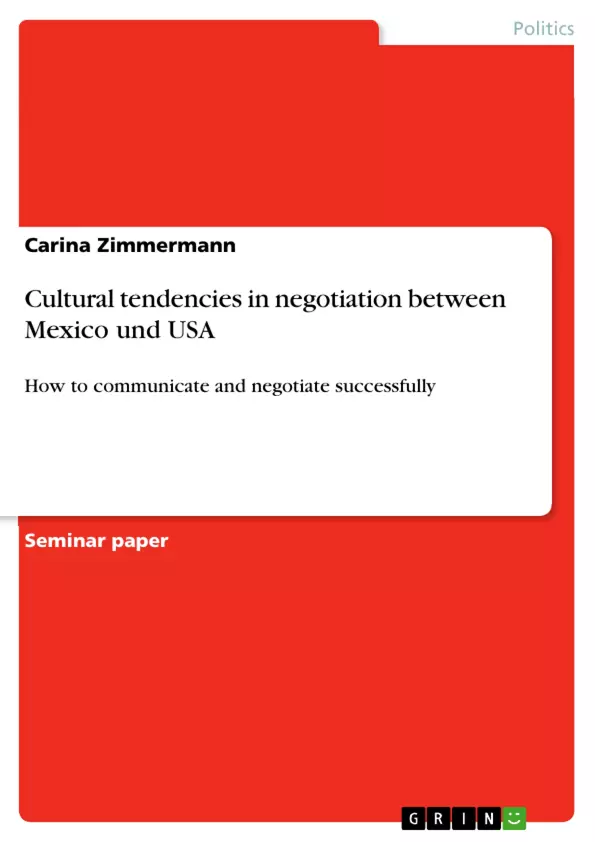As a result of globalization we are no longer dependent of distance or borders and where we do business. Due to a huge increase in global trade, learning more about how to do international business successfully is becoming more and more important. Therefore, intercultural communication and negotiation are significant for success in a globalized workplace. Becoming confident with different languages, communication styles, negotiation tactics, decisionmaking and cultural differences is the key factor for a good business relationship with other countries.
As a neighboring country and member of NAFTA, Mexico and his market had become very attractive for Americans. Although they are neighboring countries, there are big cultural differences between them which leads to misunderstanding and misinterpreting in private life as well as but in business contexts.
The purpose of this paper is in which areas of contact most commonly cause misunderstanding in intercultural communication between USA and Mexico. International negotiations deals not only with crossing borders, also with crossing cultures. Culture profoundly influences how people communicate, think and behave in business situations. Therefore the main questions in this paper are: How cultural aspects affect business communication between Mexico and the United States? How can business people profit from cultural awareness? Which rules do they have to follow for a successful negotiation?
Inhaltsverzeichnis (Table of Contents)
- Introduction
- Historical and political background
- Social communication factors
- Hierarchy
- Individualism vs. Collectivism
- Gender roles
- Other values
- USA and Mexico-differences in intercultural communication
- Chronemics
- Context
- Proxemics and Kinesics
- Cultural interactions
- Written communication
- Language and languagestyle
- Negotiating successfully with Mexicans
Zielsetzung und Themenschwerpunkte (Objectives and Key Themes)
This paper examines the cultural differences that can lead to misunderstandings in intercultural communication between the United States and Mexico. It aims to identify the areas of contact most commonly causing these misunderstandings and explore how cultural awareness can improve business communication and negotiation between the two countries.
- Historical and political background as a source of cultural differences
- Cultural factors influencing communication styles, including hierarchy, individualism vs. collectivism, and gender roles
- Differences in intercultural communication, including chronemics, context, proxemics, and kinesics
- Cultural interactions in written communication and language style
- Successful negotiation strategies for American business partners dealing with Mexican counterparts
Zusammenfassung der Kapitel (Chapter Summaries)
Chapter 1: Introduction
This introductory chapter sets the context for the paper by highlighting the growing importance of intercultural communication and negotiation in a globalized world. It emphasizes the specific challenges posed by cultural differences between the USA and Mexico, particularly in business contexts. The chapter outlines the paper's objectives and the main questions it seeks to address.
Chapter 2: Historical and political background
This chapter delves into the historical and political backdrop of the relationship between the USA and Mexico. It explores the influence of indigenous cultures, the different historical trajectories of the two countries, and the impact of events like the Mexican-American War and the U.S. military intervention in 1916. It highlights the lasting impact of these events on Mexican perceptions of the USA and the ongoing challenges to building a more positive relationship.
Chapter 3: Social communication factors
This chapter examines key cultural factors that shape communication styles in Mexico and the USA. It explores the importance of hierarchy in business negotiations, the differences between individualistic and collectivist societies, and the role of gender in both cultures. The chapter also discusses other values, such as family concepts, thought patterns, and religion, which influence daily interactions and business relationships.
Chapter 4: USA and Mexico-differences in intercultural communication
This chapter focuses on specific differences in intercultural communication between the USA and Mexico. It examines how time perception, communication styles (high-context vs. low-context), proxemics, and kinesics can lead to misunderstandings. The chapter provides a detailed analysis of these factors and their implications for effective communication and negotiation.
Chapter 5: Cultural interactions
This chapter focuses on the nuances of intercultural interactions between the USA and Mexico. It delves into differences in written communication styles and the impact of language and language style on communication. The chapter provides insights into how these cultural variations can influence the effectiveness of communication and negotiation.
Schlüsselwörter (Keywords)
Intercultural communication, negotiation, Mexico, USA, cultural differences, historical background, political relations, social communication factors, hierarchy, individualism, collectivism, gender roles, chronemics, context, proxemics, kinesics, written communication, language style, negotiation strategies.
- Arbeit zitieren
- Carina Zimmermann (Autor:in), 2014, Cultural tendencies in negotiation between Mexico und USA, München, GRIN Verlag, https://www.hausarbeiten.de/document/339764


